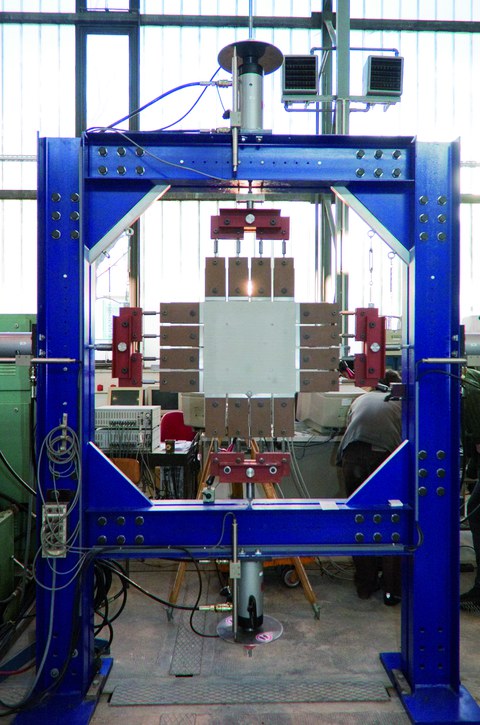SFB 528-B1: Experimentelle Ermittlung des Spannungs-Dehnungs-Verhaltens von Textilbeton
Inhaltsverzeichnis
Projektdaten
| Titel | Title SFB 528-B1: Experimentelle Ermittlung des Spannungs-Dehnungs-Verhaltens von Textilbeton | CRC 528-B1: Experimental determination of the stress-strain behaviour of TRC Förderer | Funding Deutsche Forschungsgemeinschaft (DFG) / SFB 528 Zeitraum | Period 07/1999 - 06.2011 Leiter | Project managers Prof. Dr.-Ing. Manfred Curbach, Dr.-Ing. Frank Jesse Bearbeiter | Contributor Dr.-Ing. Frank Jesse, Dipl.-Ing. Dirk Jesse, Dipl.-Ing. Katrin Schwiteilo |
Siehe auch Projekthomepage
Bericht aus dem Jahrbuch 2009
Zweiaxiales Tragverhalten von Textilbeton

Versuchsaufbau für zweiaxiale Zug-Zug-Versuche
Textilbewehrter Beton (TRC) ist ein neuer
Verbundwerkstoff, dessen Bewehrung aus
technischen Textilien (aus Garnen/Rovings) verschiedener Materialien besteht. In den zurückliegenden Phasen des SFB 528 wurden dessen Materialeigenschaften unter einaxialer Zugbeanspruchung und unter Biegebeanspruchung bereits eingehend untersucht. Demnach gibt es eine starke Abhängigkeit des Tragverhaltens von den Verbundeigenschaften sowohl zwischen den Filamenten als auch zwischen Filamenten und Matrix. Auch Teilaspekte einer kombinierten Belastung wie Rissuferverschiebung oder nicht achsparallele Zugbeanspruchung wurden bereits mit einbezogen.
Bei zweiaxialer Belastung mit Zug in einer Hauptrichtung und Druck in Querrichtung kommt es zu einer Erhöhung der Tragfähigkeit. Eine Querzugbeanspruchung ohne Druckkomponente in der zweiten Richtung führt hingegen zu einer Verringerung der Tragfähigkeit. Zum Spannungs-Dehnungs-Verhalten unter Zug-Zug-Beanspruchung in Abhängigkeit des Spannungsverhältnisses σ1/σ2 gibt es bisher nur sehr wenige Erkenntnisse.
Von Zug-Zug-Versuchen an Stahlbetonbauteilen ist bekannt, dass bewehrungsparallele Risse den Verbund zwischen Stahl und Beton stören und damit die Mitwirkung des Betons zwischen den Rissen reduzieren. Die bekannt hohe Sensitivität des Tragverhaltens von textilbewehrtem Beton gegenüber den Verbundeigenschaften der
Bewehrung lässt vermuten, dass durch Zugbeanspruchung in einer Richtung induzierte Risse einen signifikanten Einfluss auf das Tragverhalten in die jeweils andere Richtung ausüben.
Experimentelle Untersuchungen. Diese und weitere Fragen wurde experimentell an scheibenförmigen Proben unter Zug-Zug-Beanspruchung untersucht. Diese technologisch bedingte Asymmetrie der Bewehrung (Kett- und Schussfäden) bedingt Untersuchungen des gesamten Zug-Zug-Quadranten, um das Materialverhalten in Schuss- und Kettrichtung sowie bestehende Abhängigkeiten vollständig zu erfassen.
Auswertung der Versuche. Erwartungsgemäß lässt sich im ungerissenen Zustand I kein Einfluss der Bewehrung nachweisen. Das Spannungsniveau der Erstrissbildung (Übergang Zustand I/Zustand IIa) sinkt hingegen proportional zum Spannungsverhältnis σ1/σ2. Ein direkter Einfluss von bewehrungsparallelen Längsrissen auf das Spannungsniveau der Erstrissbildung ist aber nicht erkennbar.
Deutliche Auswirkungen zeigen sich im Dehnungsverhalten nach Abschluss der Rissbildung (Zustand IIb), wenn sich das bewehrungsparallele Risssystem infolge Querzugbeanspruchung weitgehend ausgeprägt hat.
Ein Einfluss auf den Bruchzustand ist aus den Versuchsdaten hingegen nicht erkennbar. Die gewählte Probekörpergeometrie ist nicht frei von lokalen Spannungskonzentrationen, welche überwiegend das Versagen einleiten und wodurch materialspezifische Effekte ggf. überdeckt werden. Genauere Untersuchungen zum Bruchzustand sind Bestandteil laufender Untersuchungen.
